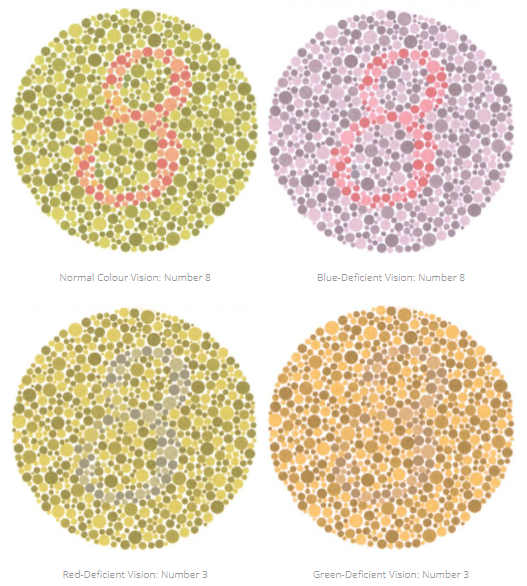How People with Colour Vision Deficiency See Christmas

Cities light up in red and green every December as the streets come to life with Christmas festivities. Huge, green Christmas trees tower over busy shoppers, bedecked in brightly coloured baubles, tinsel, and fairy lights.
To most people, Christmas is a colourful affair. However, to some people with colour vision deficiency, Christmas looks entirely different.
What is Colour Vision Deficiency?
Colour Vision Deficiency (CVD) is the inability to identify and distinguish between colours. Most people with mild colour deficiencies have difficulty differentiating similar colours or shades of a particular colour spectrum, especially with red and green. It is also often known as ‘colour blindness’, although this term can be misleading because very few people are completely colour blind. ‘Total colour blindness’, which everything is seen in shades of grey, is extremely rare.
Around the world, about eight per cent of men and 0.5 per cent of women have a colour vision defect1.
What are the Common Types of Colour Vision Deficiency?
Specialised cells in the eye allow us to appreciate colour. They contain three pigments that are sensitive to light: red, green, and blue. Those with defective colour vision have a deficiency or absence in one or more of these pigments.
Red-Green Deficiency
The most common type of deficiency, those affected have trouble distinguishing between some shades of red and green. Their visual acuity, or clarity of vision, is not affected.
Blue-yellow Deficiency
Blue-yellow colour deficiency is much less common. This type of colour deficiency makes it difficult to differentiate between blue and green, and between yellow and red.

Complete Achromatopsia
This condition means total colour blindness, where everything is seen in white, black, and shades of grey. This is extremely rare, affecting about one in 30,000 people.

What Causes Colour Vision Deficiency?
CVD may be a hereditary condition or caused by disease of the eye (specifically the optic nerve or retina, such as glaucoma, diabetes, or multiple sclerosis). Inherited CVD is most common, and it usually affects both eyes, and does not worsen over time.
How is Colour Vision Deficiency Diagnosed?
CVD is most commonly detected through screening at a young age or in school. The child may have difficulty with activities involving colours in school, such as games and reading off the white board.
Colour vision is tested with specially coloured charts such as the Ishihara Test Plates. On each plate is a number composed of coloured dots. This number is coloured in a ‘pseudoisochromatic’ way, which means that the dots appear to be the same (-iso) colour (-chromatic) as the surrounding pattern. However, to a person with normal colour vision, they do not appear the same (-pseudo). While holding the chart under good lighting, the patient is asked to identify the number. Those with normal vision see a number while those with colour vision defects see none, or see a different number. Once the colour deficiency is identified, more detailed colour vision tests may be performed.
A person could very well have poor colour vision and not be aware of it, because they have learnt to see the ‘right’ colour. For example, they know that tree leaves are ‘green’, so the colour they see becomes ‘green’ to them.
Here is an example of four different views of the same Ishihara Test Plate that tests for red-green CVD. Those with normal and blue-deficient vision see the number ‘8’, while people with red-green deficiency see it as number ‘3’.

Can Colour Vision Deficiency Be Cured?
There is no treatment or cure for congenital colour blindness. Those with mild colour deficiencies learn to associate colours with certain objects and are usually able to identify colour as everyone else. However, they are unable to appreciate colour in the same way as those with normal colour vision. If the cause is a disease or eye injury, treating these conditions may improve colour vision.
What Can You Do If You Have Colour Vision Deficiency?
Most people with mild CVD are not affected in most of their daily activities. They learn to associate and recognise colours in their own ways.
In certain countries, they may be fit to drive if they can identify the three colours of traffic light correctly (red, amber, green).
However, they may not be allowed to work in certain vocations where colour differentiation is crucial, for example, working as an electrician.
Here are some ways to cope with CVD:
- Using special tinted eyeglasses or contact lenses can increase some people’s ability to differentiate between colours, although it cannot help them to truly see the deficient colour.
- Organise and label furniture, clothing, or other coloured objects for ease of recognition.
- Remember the order of things rather than the colour. For example, a traffic light has red on top, yellow in the middle, and green on the bottom.
- Using technology such as software and apps to help people with CVD distinguish different shades and colours.



